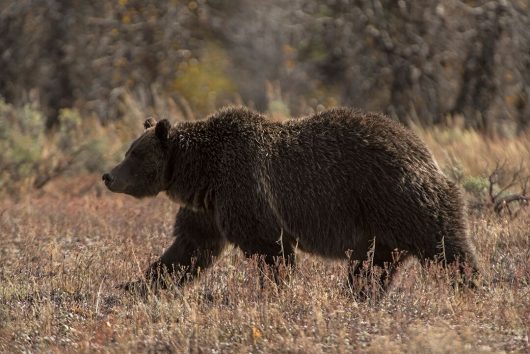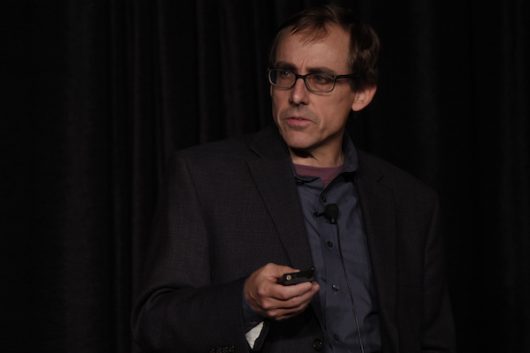
Grizzly 399 walks through Yellowstone National Park. Credit: Courtesy of Thomas Mangelsen
Yellowstone, the world’s first national park, is full of hidden wonders like volcanos, mountains and hot springs. But it’s also home to one of the most famous grizzly bears in the world: Grizzly 399.
Grizzly 399 has given birth to over 16 descendents, but because of human interactions such as illegal hunting, over half of her cubs have died.
Todd Wilkinson, an environmental journalist published in National Geographic and Nature magazines, said in a speech at Ohio State on Monday that every summer lots of Ohioans visit Yellowstone National Park to see grizzlies like 399.
“This pilgrimage from Ohio to Yellowstone has been going on for generations,” Wilkinson said during the Monday evening presentation put on by Ohio State’s Environmental Professionals Network at the Ohio Union. “It’s made evident how beloved the West is among Ohioans.”
The problems Yellowstone grizzlies are facing, such as habitat disruption and loss of food sources, can seem distant to students, but Wilkinson says grizzlies and the land they live on belong to everyone.
“(Students) have a place in Yellowstone themselves,” he told The Lantern. “You know what? Don’t watch 399 on your cellphone or laptop. But go out and see the bears of Yellowstone firsthand.”

Todd Wilkinson speaks at the Archie Griffin Ballroom in the Ohio Union on Oct. 24. Credit: Ris Twigg | For The Lantern
Wilkinson told the crowd during his speech that in order to save grizzly bears, students need to “embrace the West as part of your own legacy.”
Sean Masterson, a first-year in exploration, said Yellowstone was the most memorable national park he’s ever visited.
“Seeing the grizzly bear in the park was really cool and also sad,” he said. “(It taught me to) respect the animals we share this Earth with.”
Nature photographer Thomas Mangelsen, who also presented at the event, spoke out against different groups that are trying to turn federal lands like Yellowstone into areas managed by individual states.
“But Ohio has a piece of Yellowstone just like I do, and I live next door,” he said.
Wilkinson recently wrote “Grizzlies of Pilgrim Creek: An Intimate Portrait of 399,” a book accompanied by Mangelsen’s photos of 399 and her cubs, detailing the struggles and triumphs of their lives.
The pair focused on the effects of delisting of grizzlies from the Endangered Species List — they’re now listed as “threatened,” which comes with less federal protections — and the variety of problems affecting their survival, including climate change, loss of food and hunting.
Wilkinson shared a story about Dennis VanDenbos, a science teacher from Wyoming who decided to take a walk through Grand Teton National Park one morning.
During his morning stroll, VanDenbos unintentionally walked up to 399 and her cubs.
399 charged at VanDenbos and bit him three times before someone drove by and screamed, sending 399 for cover behind the trees.
Wilkinson said VanDenbos didn’t want the park rangers to kill the bear. He said 399 was only following her instinct to protect her cubs.
“We are going into their homes and we can leave,” Wilkinson said to the crowd. “Often times these are the only places these animals have.”
Wilkinson also recounted the deaths of some of 399’s cubs, explaining that birth rates in grizzly populations are remarkably slow, so each cub death takes a significant toll on the population.
Wilkinson and Mangelsen are hopeful that 399 will leave her den at the end of this winter with a new cub by her side.
Brittany Lorish, a fourth-year in natural resources management, said she was inspired by the personality Wilkinson and Mangelsen put behind 399.
“We saw that 399 was a mother, she was a hunter, she was multiple facets of life,” Lorish said. “I’ve never seen her before, but I feel like I know her.”
Mangelsen and Wilkinson presented in several classes on Monday and Tuesday. The pair are set to speak at a follow-up event detailing Ohioan Ted Turner’s achievements as a private landowner concerned about the environment. The event will be held on Tuesday evening in the U.S. Bank Conference Theater, starting at 7 p.m.


